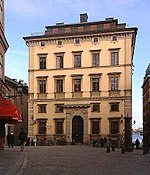Black Friars' Monastery of Stockholm
1336 establishments in Europe14th-century establishments in Sweden1547 disestablishments in SwedenBuildings and structures demolished in the 16th centuryChristian monasteries established in the 14th century ... and 6 more
Demolished buildings and structures in SwedenDominican monasteriesHistory of StockholmMedieval SwedenMonasteries dissolved under the Swedish ReformationRoman Catholic monasteries in Sweden

The Black Friars' Monastery, Svartbrödraklostret, also called the convent of Stockholm, was a Dominican monastery on the island of Stadsholmen (City Island) in central Stockholm, founded by King Magnus IV in 1336 when he donated a plot of land located in the southern part of Stadsholmen to the Black Friars. By order of Gustav Vasa the monastery was demolished in 1547, but some of the vaults are still preserved and can be visited. Today Svartmangatan (Blackman Street), which led down to the monastery, is still reminiscent of the Black Friars' era.
Excerpt from the Wikipedia article Black Friars' Monastery of Stockholm (License: CC BY-SA 3.0, Authors, Images).Black Friars' Monastery of Stockholm
Svartmangatan, Stockholm Gamla stan (Södermalms stadsdelsområde)
Geographical coordinates (GPS) Address Nearby Places Show on map
Geographical coordinates (GPS)
| Latitude | Longitude |
|---|---|
| N 59.323333333333 ° | E 18.073333333333 ° |
Address
Svartmangatan 24
111 31 Stockholm, Gamla stan (Södermalms stadsdelsområde)
Sweden
Open on Google Maps











